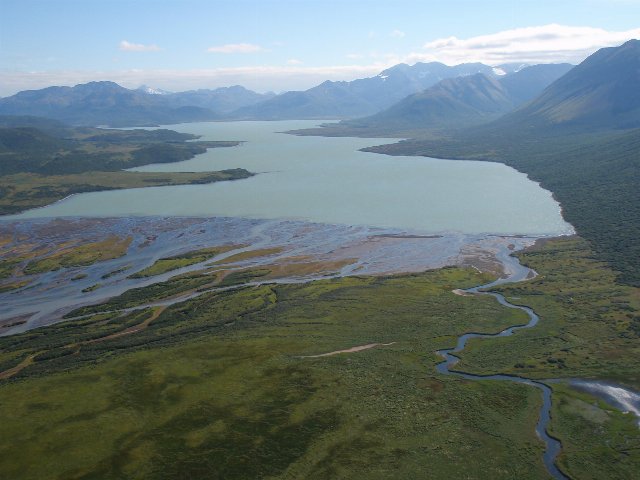Home » Regions » North America » Marine West Coast Forest » Alaska Peninsula Mountains
Alaska Peninsula Mountains
Last updated: August 28th, 2024
Page contents
↑About the Alaska Peninsula Mountains
The Alaska Peninsula Mountains extend along the south side of the Alaska Peninsula, also called the Aleutian Peninsula, and onto Unimak Island, the first and largest of the Aleutian islands, as well as including some other islands to the east, the largest of which is Kodiak Island. This region tends to be rugged, sparsely-populated, and mostly covered in low scrub growth. Although our classification scheme lumps this region in with the Marine West Coast Forest, this region is not really forested, although it does support lush growth of lower-growing woody plants. The region can be seen as transitional between the conifer-dominated marine West Coast forests and open tundra.The cool, humid climate here is shaped by the presence of the Aleutian Low, which both generates and strengthens storms, and attracts storm systems to this area; the low weakens or dissipates in summer. This region's climate straddles the border of most classification schemes, usually being classified as towards the cold end of an oceanic or maritime climate, but tending towards subarctic at mid elevations and tundra at high elevations, and with some small regions of cold-summer Mediterranean climate on the northwestern side of mountains. Temperatures are moderate year-round, having only a weak seasonality, with winter temperatures only about 25°F (14°C) lower than summer. Rainfall in most of the region is extraordinarily high, especially relative to such a cold region. Although precipitation is high year-round, it is slightly lower in early summer. Winter snowfall is heavy, but accumulation is minimal at sea level because winter highs reach well above freezing on most days. At higher elevations, higher snowfall and colder temperatures lead to great snow accumulation, which help glaciers to persist even with the more moderate temperatures and relatively small areas of high elevation. An exception to the pattern of high precipitation is found on the lower, northwestern slopes of larger mountains, where rain shadow produces small areas with a dramatically drier climate; the largest such area occurs around Larsen Bay on Kodiak Island.
The terrain is rugged, with elevations spanning from 2,600m (over 8,500 ft) to sea level. Much of the mountains consist of folded and faulted sedimentary ridges, but there are also volcanoes reaching even higher. The terrain has been heavily glaciated, and some glaciers remain at the highest elevations. The region is also volcanically and tectonically active, and subject to both earthquakes and volcanic eruptions. The shape of the terrain is different in areas bordering flatter land vs. water. Along the ocean, particularly on the south side, there are deeply-cut fjords. The north side of the mountains tends to be smoother and marked by glacial moraines. There are numerous high-gradient streams throughout, which tend to be fed by glacial meltwater where glaciers exist. There are some larger lakes on the north sides of the mountains where glacial moraines have blocked drainage; some of these lakes lie entirely within this region, whereas others are partly or entirely in the flatter region to the northwest. Soils are mostly formed on volcanic ash and cinder, which lies atop glacial deposits; these soils are prone to erosion. Excluding the highest elevations covered in glaciers, most of this region is free of permafrost.
The dominant vegetation cover here is low-growing scrub, rich in woody plants but with the largest being more shrub-sized. Low elevations and more sheltered sites support willow, birch, and alder, with ericaceous plants, Dryas and lichens. Higher elevations support dwarf scrub growth which transitions to open tundra at the highest elevations and on sites more exposed to wind, and glaciers around the highest peaks.
Most of this region is sparsely populated. The only settlement of significant size is Kodiak, with a population of about 5,500 and decreasing. Outside of Kodiak island, the largest settlement measured by permanent residents is Chignik, with under 100 people. There are numerous other small settlements along the coast. Some settlements have little permanent population and house mainly seasonal workers for the fishing industry, but some have a few hundred such seasonal workers. Land use here is sparse, consisting of both subsistence and recreational hunting and fishing, and commercial fishing and fish processing. There is some mining of minerals and coal, and some oil extraction.
Along most of the length of the portion of this region on the Alaska peninsula, it is bordered to the northwest by the lower, flatter Bristol Bay-Nushagak Lowlands which features open tundra. A small part of Kodiak island also borders the warmer, more forested Coastal Western Hemlock-Sitka Spruce Forests, which extends eastward and then south along the West Coast of North America. At the southwest end of this peninsula, separated by a short distance of water, the Aleutian Islands begin, a region similar to the lower elevations of this region but forming an island bridge to Asia and beginning to transition to Asian flora. Although technically an island, the first and largest of the Aleutian Islands, Unimak island, is lumped with the Alaska Peninsula Mountains because it is separated from the mainland only by a narrow channel, and it has a larger area and higher elevations more typical to the mountains on the mainland, whereas the islands farther southwest are lower and separated from each other by larger distances of water.
 This photo shows Chignik Lake, one of the larger lakes in the Alaska Peninsula Mountains. The rugged terrain is typical of the region; note a complete lack of large trees in spite of the lush, green appearance throughout. Although this region supports quite a lot of woody plants, they are restricted to low, scrubby growth and shrubs. Photo © U.S. Fish & Wildlife Service, Alaska Region, Public Domain, Source.
This photo shows Chignik Lake, one of the larger lakes in the Alaska Peninsula Mountains. The rugged terrain is typical of the region; note a complete lack of large trees in spite of the lush, green appearance throughout. Although this region supports quite a lot of woody plants, they are restricted to low, scrubby growth and shrubs. Photo © U.S. Fish & Wildlife Service, Alaska Region, Public Domain, Source.

